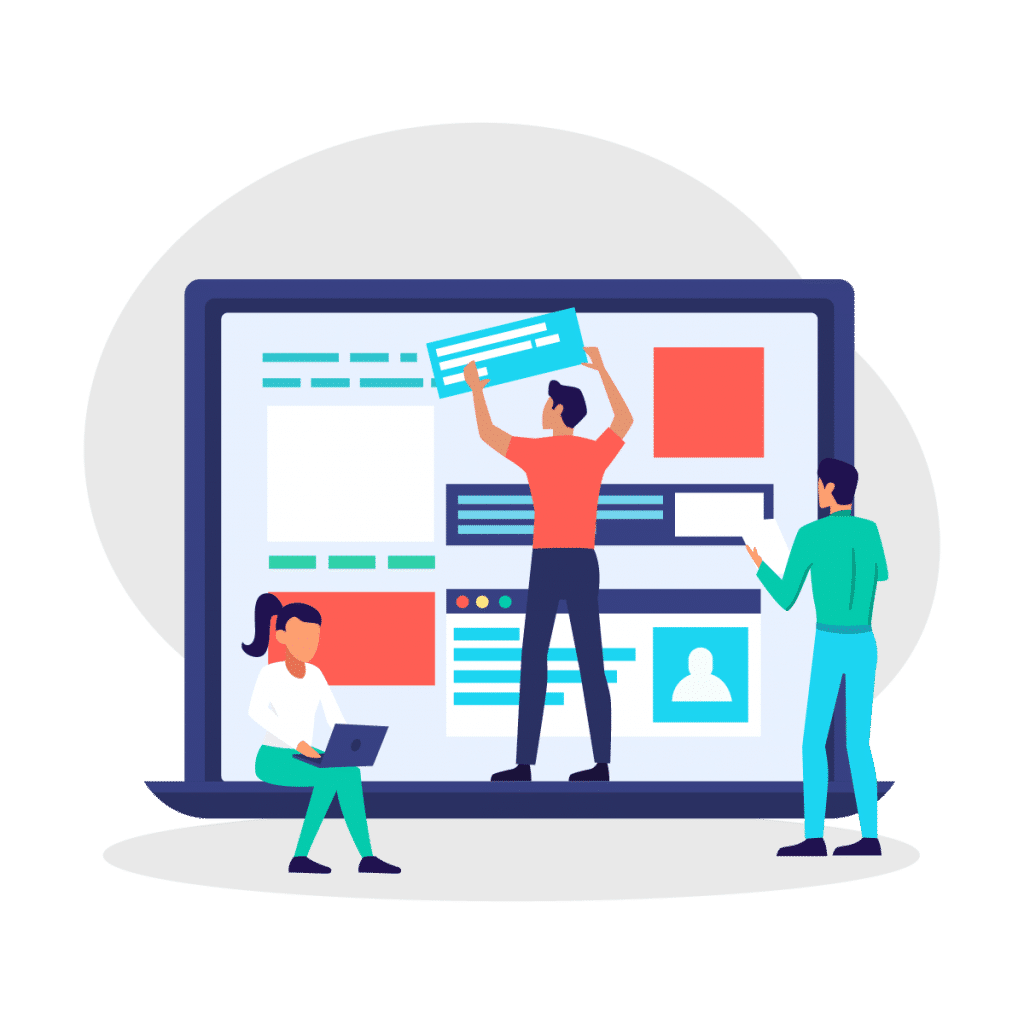
Around 90% of leading marketers agree that personalization plays a major role in enhancing business profitability.
Personalization is a robust marketing tactic that drives conversions and sales. According to recent research:
✅ Around 80% of consumers prefer doing business with a brand that delivers personalized experiences.
✅ Over 60% of people expect brands to tailor experiences based on their preferences.
As you can see, there’s never been a better time to invest in personalization. If you’re not sure where to begin, personalizing your website is a good first step.
Using the right tools, you can personalize your website’s headlines, calls to action (CTAs), images, QR codes, and more.
In this article, we’ll explain how you can personalize your website and deliver tailored experiences to your target audience.
What Is Website Personalization?
Website personalization is the practice of building a customized website experience for each visitor.
Instead of offering a one-size-fits-all experience, website personalization allows you to display dynamic content tailored to each visitor’s preferences and characteristics.
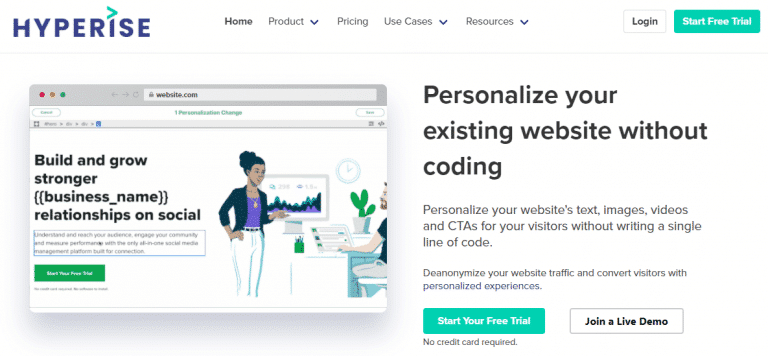
Also known as web content personalization, this strategy was impossible to implement until a couple of years ago.
Today, using the right tools, you can personalize your website in various ways and reap multiple benefits, including:
- Fostering a positive brand perception among your target audience.
- Delivering an exceptional customer experience.
- Earning the trust of potential customers.
- Differentiating your brand from your competitors.
- Enhancing customer satisfaction and generating more referrals.
By leveraging website personalization, you can cultivate positive feelings towards your business to help increase the chance of conversions and boost sales.
How Does Website Personalization Work?
Personalized websites are designed to be dynamic, meaning they change according to the person viewing your site.
To create an effective personalized website, you need to collect data from your audience that will allow you to segment site visitors into groups.
Then, you will be able to target each type of prospective customer with curated content that will draw them into the sales funnel.
This means that website personalization may involve collecting and using visitor data such as:
💡 Psychographics: This is information like people’s interests, attitudes, values, lifestyle, and personality traits.
💡 Demographics: This is data like age, gender, income, or education level.
💡 Firmographics: Data that pertains to businesses, such as their industry and company size.
By integrating this data, your website can be programmed to display content most relevant to these specific attributes.
Why Are Personalizing Websites Important?
One of the biggest reasons website personalization should play a significant role in your marketing strategy is that it helps you build meaningful connections with your website visitors.
By personalizing their experience, users may feel like you really understand them and they’ll appreciate the extra effort.
This may make them more likely to notice your brand and support your business.
Why Do Consumers Prefer Personalization?
Consumers prefer personalized experiences because they:
- Want to be recognized: People want to be seen and appreciated for who they are. Personalization makes them feel valued and like they aren’t just another anonymous website visitor.
- Crave control: In an unpredictable world, people want to feel in control. A personalized web experience gives your visitors a sense of confidence to make good buying decisions.
- Are overloaded with information: Consumers are bombarded with hundreds of impersonal marketing messages each day. A tailored experience stands out from other marketing tactics.
| Key Point: What Is The Best Type of Personalization? The best type of personalization for your brand will depend on your audience and user behavior. However, personalized emails often stand out as a highly effective method for customer conversion. Research shows that these emails often receive 11% higher open rates than ones that aren’t personalized, meaning they are more effective at reaching potential customers. For website-specific personalization, dynamic content that adjusts based on a user’s past behavior and preferences is usually the most effective. In fact, incorporating dynamic content into your website can often increase your conversion rates by more than 30% and click-through rates by 35%. |
What Are the Benefits of Website Personalization?
Is website personalization worth all the investment? Here are just some of the benefits of this marketing tactic:
👍 Optimized user experience (UX)
A major perk of website personalization is the enhanced user experience (UX) it offers as visitors navigate your site.
The better their experience of your website, the more likely users are to convert into paying customers.
Another way website personalization results in a positive UX is by allowing you to offer relevant product recommendations for each unique visitor. Intuitive product recommendations make your visitors feel like your website was built especially for them.
👍 Lower bounce rates
Website personalization can help lower your bounce rates and make the content more relevant to each visitor. This is achieved through:
- User-specific navigation paths.
- Adaptive content and offers based on location data, time of visit, and browsing history.
- Enhanced interactivity through elements like quizzes, polls, or personalized recommendations.
When the content on your site is hyper-relevant to users because it’s been personalized, they’ll likely spend more time engaging with your website.
👍 Higher conversion rates
Higher conversion rates translate to increased revenue. Personalized web experiences can help you achieve more conversions.
Consumers are more likely to buy from brands that go the extra mile to serve them relevant content.
Personalized websites also convert well because they build trust with visitors. Consumers tend to trust brands that show they’ve taken the time to understand them better.
Website personalization also helps improve conversions by speeding up the buying process. As you intuitively serve your visitors with all the information they need, they progress through your sales funnel faster.
A personalized website can also provide a highly effective way to increase site visit time.
When a site visitor is targeted with relevant and timely ads, pop-ups, or banners, they may feel more inclined to stay on the website longer.
The longer you can keep visitors on your website, the better your chances of making a sale.
👍 Improved customer loyalty and retention
People enjoy personalized web experiences over generic ones. If you offer a personalized experience, it’s likely your customers will support you again.
When it comes to web personalization, 56% of consumers said they’d become repeat customers if a brand:
- Recognizes them by name: Personalization transforms a digital interaction into a more human experience, making customers feel valued and seen. This can be as simple as integrating personalized greetings in emails or updating your website to welcome returning visitors.
- Knows their purchase history: When a brand remembers a customer’s previous purchases, it can streamline their shopping experience while showing attentiveness. This can help you provide recommendations for relevant products that can improve a customer’s view of your brand’s service quality.
- Can offer personalized recommendations: Using a customer’s past behavior to suggest relevant products and services is a powerful way to increase engagement. These recommendations often feel thoughtful and personal, helping them to meet the interests of the customer.
- Encouraging feedback and participation: Inviting customers to provide feedback on personalized experiences not only helps improve these services but also makes clients feel their opinions are valued. This engagement can further deepen their brand loyalty.
👍 High-performing landing pages
Landing pages play a crucial role in your sales and marketing funnel. And because they’re usually the first point of contact your customers have with your brand, you should make a strong impression—personalization helps with this.
In one example, Intercom achieved a 300% increase in its landing page conversion rate by leveraging personalized website images.
👍 Improved lead quality
Website personalization allows you to nurture leads from their first encounter with your brand to post-sales relationships.
By tailoring the user experience from the initial interaction through to the post-sale follow-ups, you can ensure that each lead is aligned with your brand’s offering.
As a result, most leads navigating your sales funnel are high-quality and have a higher likelihood of conversion.
How Do I Personalize My Website?
While it may sound complex, website personalization is relatively easy to get right.
All you need is a solid personalization strategy and the right tools to execute it. One such tool is Hyperise.
Using the Hyperise toolkit, you can personalize elements of your website, such as text, images, and CTAs for each visitor. All this without having to write a single line of code.
Here’s how you can incorporate personalization within your website using Hyperise and a few other platforms:
➡️ Invest in the right tools
Personalizing a website is virtually impossible without the right tools. This is because:
- There are too many personas to personalize, and doing so at scale requires automation.
- You need to personalize in real-time using consumer data, which requires an intuitive tool.
Other than Hyperise, you may also want to consider analytics tools, customer relationship management (CRM) software, and landing page builders.
Later in this article, we’ll discuss how to choose the right personalization tools for your business.
➡️ Understand and segment your audience
Analytics platforms like Google Analytics and HotJar can help you analyze the visitors’ behavior on your website.
Understanding how they interact with your site is crucial to developing an effective website personalization strategy.
Segmenting your audience is the best—and easiest—way to personalize at scale.
With segmentation, you can effortlessly craft messaging and offers tailored to different categories and deliver content based on what you know about your customers.
➡️ Define your KPIs
To know if your website personalization strategy is working, you need to define the key performance indicators (KPIs) you’ll use to measure success.
Examples of metrics you can use to track the performance of your personalization strategy include:
- Dwell time (the average time spent on your site).
- Bounce rates.
- Conversion rates.
- Web pages clicked per visit.
Tracking relevant KPIs is crucial for personalized campaigns, as it helps you understand which parts of your strategy are effective and what adjustments are needed for success.
You should also clearly define why you want to personalize your website and what you hope to achieve from it. Examples of website personalization goals can include:
- Improving engagement rates.
- Driving sales.
- Increasing customer retention.
➡️ Gather the right data
Data plays a vital role in developing a website personalization strategy. It’s important to gather the right data to help you understand what your visitors want.
But gathering data isn’t the only thing you need to do. You should also ensure that you’re able to collect this information in real time.
You can use tools like CRM software and Google Analytics to gather the data you need for effective personalization.
Examples of data you can use for creating personalized web experiences include:
- Links clicked.
- Emails opened and interacted with.
- Purchase history (or previous behavior patterns).
- Shopping cart data (like abandoned carts).
- Searches made on your website.
- Referral sources.
By collecting enough data, you can personalize your website to suit all your audience segments. This is how you ensure visitors feel like it was designed just for them.
➡️ Create your customer journey
Effectively personalizing your website requires outlining and understanding your customer journey. This will help identify the stages where personalization can have the most impact.
To get started, map out the customer journey on your website through your customers’ eyes.
This will allow you to experience your site as your customers do and pinpoint which parts of the journey you should personalize.
Knowing your customer journey helps you understand the intent behind their website visits, enabling you to anticipate their needs at each stage and craft a unique experience.
You’ll also be able to deliver the content your customers need to convert. Executed well, this will help your visitors transition smoothly from one stage of the sales funnel to the next.
➡️ Determine what you’re going to personalize
You’ll now need to use all the insights and data you’ve gathered to decide what you’re going to personalize on your website.
It’s best to begin with the most important assets on your website, including your:
- Homepage.
- Category and product pages.
- Checkout pages.
- Landing pages.
- CTAs.
- Pop-ups.
- Blog. Checkout this guide to create a blog using Framer.
➡️ Create personalized content
Once you’ve decided what you’re going to personalize, you now need to create content for each of your customer segments.
Your content should be relevant and extremely helpful to each segment of your audience.
Then, you need to revisit your customer journey and create personalized content for each stage.
We know this may sound labor-intensive, which is why it’s important to start small, focusing on the most essential aspects of your website.
4 Website Personalization Examples and Ideas
Let’s look at a few website personalization ideas and examples to inspire you to try this tactic:
1. A personalized homepage
Imagine navigating to a business’s homepage and being greeted by a personalized headline, hero images, and more.
Using location data transferred by the visitor’s IP address, you can gather significant firmographic information to personalize your website, including your headline and images.
If visitors are using their company computers for browsing, you can use their IP address data to personalize assets. This will then speak directly to the industry the user works in—even if they’re first-time visitors.
Here’s an example of what this would look like using the Hyperise editor:
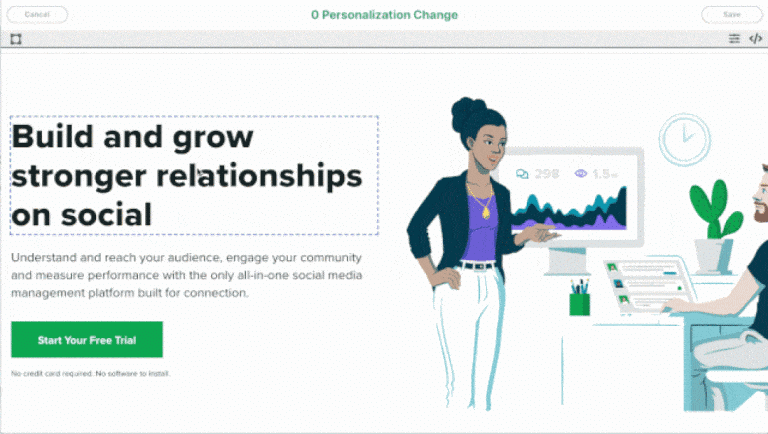
2. Personalized product recommendations
eCommerce brands with large product databases may find that their customers have a difficult time locating what they want on a website.
One way to make their experience more seamless is to use their data to serve them personalized recommendations, as you can see in the example below:

This type of personalization makes life easier for your visitors by encouraging them to buy products they may already be interested in.
More importantly, it helps boost customer satisfaction and could ultimately lead to higher retention rates.
3. Personalized pop-ups
Love them or hate them, pop-ups are an effective marketing tool. Research shows they have better clickthrough rates (CTR) compared to other ad types.
Leverage your customer data to craft personalized pop-ups and target them to the right audience segments that visit your website. Here’s an example of a personalized pop-up:
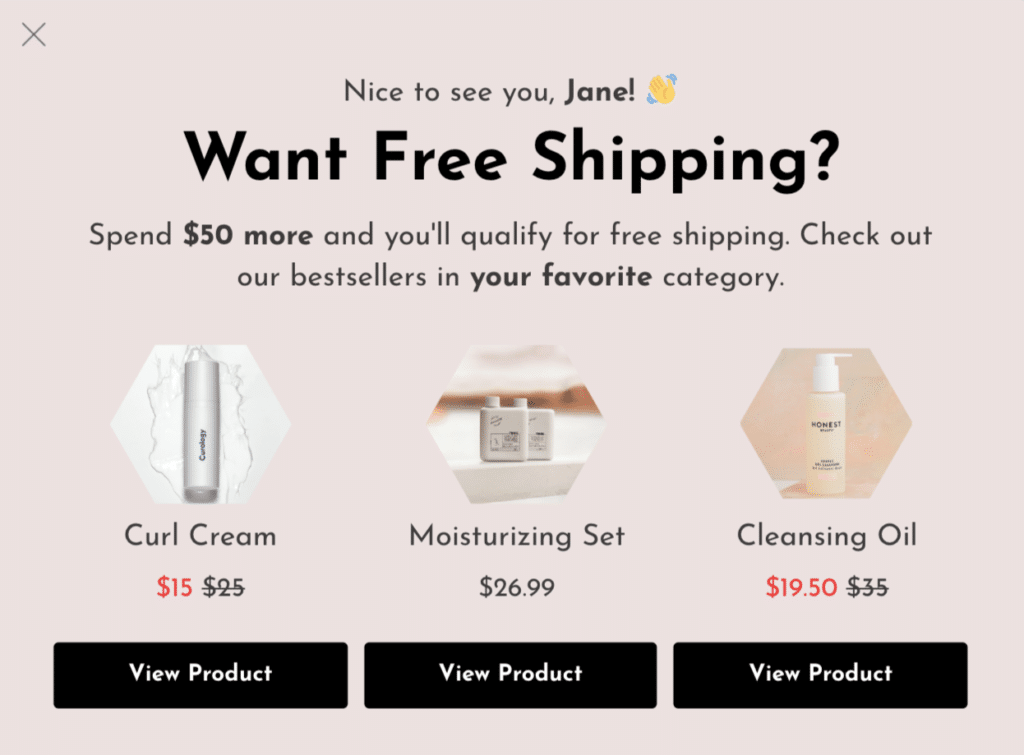
4. Personalized CTAs
Apart from personalizing general website content, you can also create custom CTAs. According to a HubSpot study, personalized CTAs perform 202% better than generic ones.
Fortunately, CTAs are among the simplest content types to personalize. The key is ensuring that the CTA directly addresses the problem that initially led the visitor to your website. Here’s an example from Billshark:
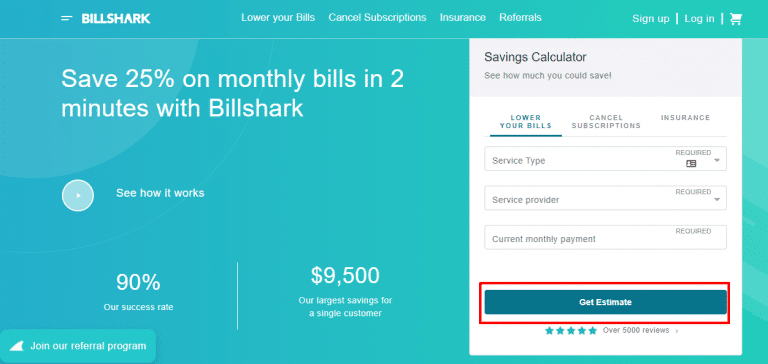
These are just a few examples of how you can add personalization to your website. Other ways can include creating personalized offers or live chat. No matter your industry or niche, you can’t afford not to personalize your website.
How to Choose Personalization Software for Your Website
As mentioned above, you need the right tools to execute an effective website personalization strategy.
Here’s what you should consider when choosing software and platforms to help you personalize your website:
✔️ Ease of use
The personalization platform you choose should be easy to navigate and utilize.
This is because the people in your business who are use this tool don’t necessarily have the technical know-how to use advanced technologies that require coding expertise.
Instead, choose a platform that allows you to create personalized assets for your website in a few clicks.
✔️ Capabilities
It’s important to select software capable of supporting the degree of personalization you want to use on your website.
For example, the right platform will allow you to personalize your CTAs, images, text, headlines, QR codes, and GIFs.
✔️ Integrations
It’s likely that your team already uses several tools within your business. Your chosen personalization software should be able to integrate seamlessly with other applications, including your CRM, email marketing platforms, and analytics tools.
✔️ Scalability
Choosing a solution that can handle website personalization at scale is important. The more prospective customers that visit your website, the more data you’ll have to implement personalization.
As your conversion rate increases and your traffic grows, you’ll need tools that will expand with you.
✔️ Trial periods and demos
Purchasing any software for your business is an investment. Choose a tool that offers a free trial or demo so that you can see its capabilities in action before you sign up.
Why You Need Hyperise in Your Personalization Toolbox
Images play a vital role in communicating with your audience. They help convey your message faster and are an effective way to elicit emotion. Personalizing the images on your website can get you even better results.
This is exactly why you need Hyperise in your website personalization toolbox.
Using dynamic personalization layers, Hyperise allows you to deliver personalized images and videos to your visitors. But our software does more than that.
The tool also enables you to personalize text, CTAs, maps, QR codes, and GIFs.
Another bonus is that Hyperise integrates with many popular marketing tools, meaning it can be used at every touchpoint along the buyer’s journey.
Regardless of your industry, Hyperise is your go-to website personalization tool.
Take Your Website Personalization to New Heights
If you want to give your prospective customers the best possible experience on your website, you need to consider personalization.
While this tactic takes a bit of time to get right initially, your website personalization efforts will pay off when you see increased conversion rates and better engagement with your site.
Additionally, personalization improves every stage of the sales process, from customer acquisition to conversion and retention, giving you an edge over the competition.
Put the website personalization strategies discussed above into action, and you’ll soon see the results of your efforts.
The easiest and fastest way to personalize your website and start reaching your goals is to use Hyperise. Sign up for a free trial and see for yourself just how easy our platform makes it for you to personalize your website and get the conversions you deserve.
Last Updated on January 22, 2025